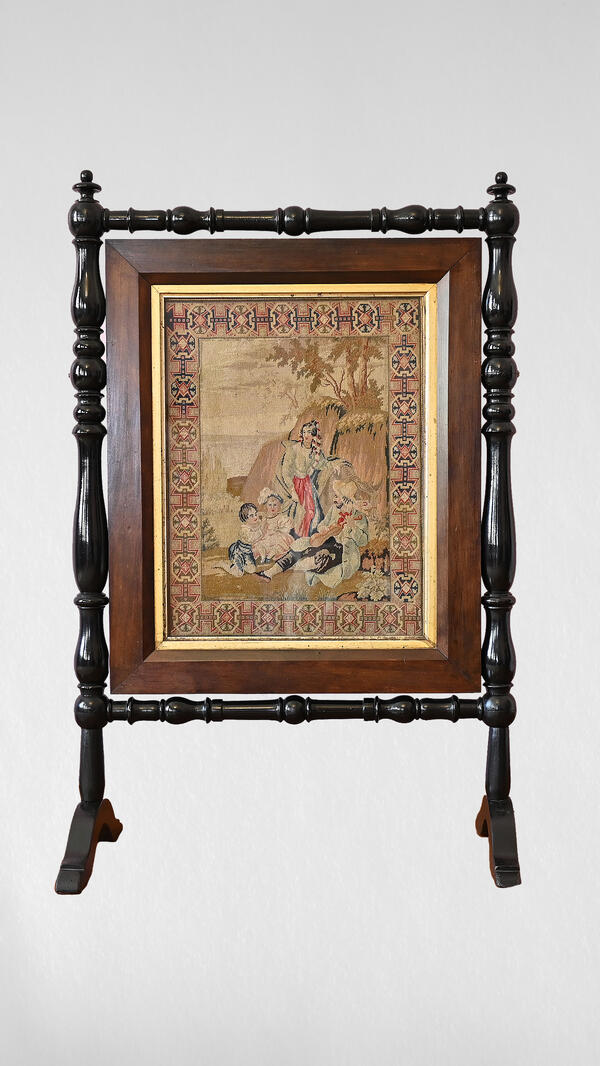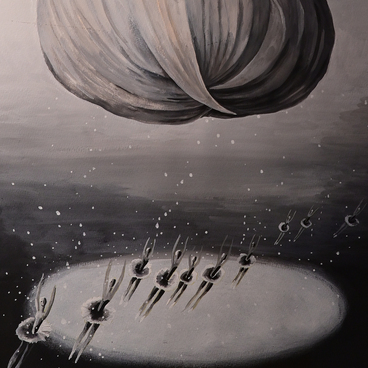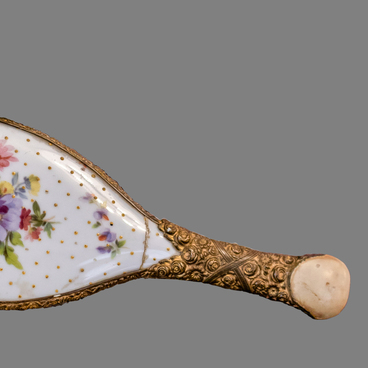The fireplace screen was transferred to the Pyotr Tchaikovsky Museum Estate in Votkinsk from the House-Museum in Klin in October 1975. Ksenia Davydova, Tchaikovsky’s great-niece, brought it from Klin. According to her, the screen was donated to the Tchaikovsky House-Museum in Klin in 1923 by Ippolit Tchaikovsky, the composer’s younger brother.
Ippolit Tchaikovsky was a Major General of the Admiralty. He participated in voyages on the ships ‘Vyborg’ and ‘Sinop’, trained as a midshipman on the ships of the Caspian Flotilla, sailed the Black and White Seas, took part in campaigns. In the spring of 1863, Tchaikovsky participated in the campaign of the Baltic squadron of the Russian Fleet. He was a member and then chairman of the Committee for the Management of the Taganrog Nautical Classes. A training vessel was built for the classes on his initiative — the barquentine ‘Saint Hippolytus’, which was renamed ‘Ippolit Tchaikovsky’ in 1920. In 1894, Tchaikovsky moved to St. Petersburg. He headed the ‘Nadezhda’ steamship company after retiring with the rank of Major General of the Admiralty. In 1919, he went to Klin, where the Pyotr Tchaikovsky Museum had already been opened. Tchaikovsky served there as a supply manager, and as a scientific secretary since 1922. He did a painstaking job of publishing the composer’s diaries in 1923 when he was working at the museum.
The embroidered screen in the Tchaikovsky house in Votkinsk stood in the office of Ilya Petrovich, the composer’s father. According to family friends, it was embroidered by Tchaikovsky’s mother, Alexandra d’Assier, on the eve of the birth of her son Ippolit.
The embroidery presents an idyllic genre scene. Four figures are depicted on a meadow. A man in a long doublet, a wide-brimmed hat with a feather and with a musical instrument in his hands sits half-turned. Two kids are depicted nearby: a boy kneeling and a girl in a beret with feathers.
The fireplace screen not only served as an interior decoration, but also protected the flooring and carpets from sparks and embers from the fire, which were dangerous due to drafts in the house. A metal sheet was attached to the back of the screen, which prevented the sparks from entering the room and reduced the heat of the flame.
Ippolit Tchaikovsky was a Major General of the Admiralty. He participated in voyages on the ships ‘Vyborg’ and ‘Sinop’, trained as a midshipman on the ships of the Caspian Flotilla, sailed the Black and White Seas, took part in campaigns. In the spring of 1863, Tchaikovsky participated in the campaign of the Baltic squadron of the Russian Fleet. He was a member and then chairman of the Committee for the Management of the Taganrog Nautical Classes. A training vessel was built for the classes on his initiative — the barquentine ‘Saint Hippolytus’, which was renamed ‘Ippolit Tchaikovsky’ in 1920. In 1894, Tchaikovsky moved to St. Petersburg. He headed the ‘Nadezhda’ steamship company after retiring with the rank of Major General of the Admiralty. In 1919, he went to Klin, where the Pyotr Tchaikovsky Museum had already been opened. Tchaikovsky served there as a supply manager, and as a scientific secretary since 1922. He did a painstaking job of publishing the composer’s diaries in 1923 when he was working at the museum.
The embroidered screen in the Tchaikovsky house in Votkinsk stood in the office of Ilya Petrovich, the composer’s father. According to family friends, it was embroidered by Tchaikovsky’s mother, Alexandra d’Assier, on the eve of the birth of her son Ippolit.
The embroidery presents an idyllic genre scene. Four figures are depicted on a meadow. A man in a long doublet, a wide-brimmed hat with a feather and with a musical instrument in his hands sits half-turned. Two kids are depicted nearby: a boy kneeling and a girl in a beret with feathers.
The fireplace screen not only served as an interior decoration, but also protected the flooring and carpets from sparks and embers from the fire, which were dangerous due to drafts in the house. A metal sheet was attached to the back of the screen, which prevented the sparks from entering the room and reduced the heat of the flame.



